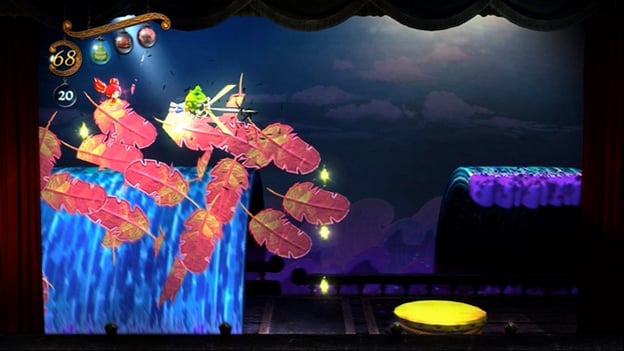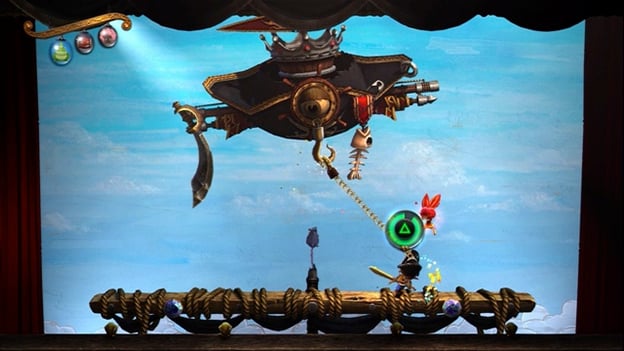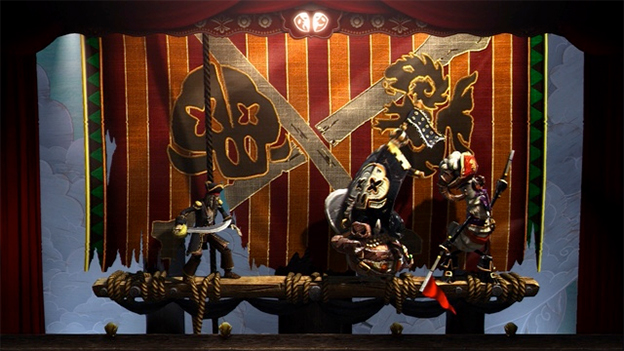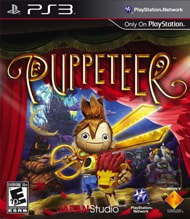Can I Get an Encore?
Puppeteer exists as a product of unhinged creativity; unhinged creativity that oftentimes takes the form of madness. This madness gives the game its energy as it rushes from one idea to the next. It could have very easily descended into senselessness, but the freshness of the core gameplay mechanics provides a solid foundation that keeps this house of anarchy from collapsing. The unique brand of insanity found in Puppeteer risks alienating some players, but it also provides those people who do enjoy it a ride unlike anything else in gaming today.
The flash of the story hides a simple narrative. At its core, you have a villain who wants power, a hero who never falters in his quest, and a wisecracking sidekick with a heart of gold. However, several hard-to-pierce trappings provide initial hurdles for players to clear. The game doesn’t take any time to set the stage, and the onslaught of fairy-tale story elements overwhelms the first few levels of the game. The main character, Kutaro, doesn’t gain his signature weapon or his permanent sidekick until the end of the first act, meaning that the game doesn’t really begin until Act 2. However, once the game gets going, it makes the slow start more than worth it.
True to its puppet-show theme, seven acts tell the story of the game. Three separate stages, called curtains, split each act. Each stage contains a plethora of platforms that Kutaro navigates. As Kutaro maneuvers through a level, a spotlight follows him. When he successfully navigates to the end of one platform, the next platform rushes forward to replace it, so Kutaro never has to leave the stage. The puppet-show setting, though, does more than just provide unique transitions between levels; it gives the game most of its humor and gameplay elements, as well.
Kutaro uses a pair of magical scissors as his main weapon. The scissors, called Calibrus, acts as both a weapon and his main method of movement. Calibrus can cut through paper materials on the stage. These materials take the shape of clouds, leaves, water, steam, and even a dragon. Kutaro can cut in any direction. Each level makes good use of this, having Kutaro travel north, south, east, and west to reach the end of a stage. This opens up each area tremendously, and the variety of ways the game utilizes Calibrus prevents it from becoming stale.
Surprisingly, without some ingenuity on the part of the developers, Puppeteer could have very easily become stale. The game is much longer than expected. Each curtain lasts roughly half an hour, give or take 15 minutes due to level variation and player skill. With three curtains an act, and seven acts in the game, Kutaro’s adventure can last anywhere from 10-15 hours. Luckily, the developers used a variety of extra weapons, some unique stages, and lively dialogue to keep the game fresh. A couple parts of the game feel like a chore, especially the first act, but energetic, entertaining levels surround each slight slog.
The pixie Pikarina accompanies Kutaro on his journey. The right analog stick moves her freely around the screen, and pressing the R2 button makes her hit background objects in an attempt to reveal items. Using the Move Controller can also navigate the pixie. Although useless in single-player (the Navigation Controller doesn’t work properly with the game), Move compatibility opens up the game to some fun co-op. (And by fun, I mean the second player can use Pikarina to torment poor Kutaro.)

By the end of the game, Kutaro employs five unique weapons. Each weapon can be effortlessly used with the push of a button, and switching between weapons is hassle free. Boss fights force players to quickly change between dropping a bomb, grabbing something with a chain, and body slamming the ground. Thanks to the easy control scheme, I rarely had issues moving from one weapon to the next. And when I did take a hit because of weapon-switching mishaps, it was completely my fault.
When Kutaro gets hit, he loses his head (literally). Kutaro can store up to three heads at once. These heads look like anything from a skeleton to strawberry shortcake. Besides just a measurement of life, heads also perform special functions. If Kutaro uses a head’s special animation in certain parts of a game, cool things happen: bonus stages open up, collectables appear, and sometimes allies help you out in tight spots. Making the extra-life system aesthetically pleasing and functionally useful layers fun onto a usually straightforward platforming staple.

Then again, not many things in Puppeteer are usual. The boss fights range from an oversized tiger to a pirate sheep/pig combo piloting a mechanical crab. These fights switch between quick-time events and normal gameplay. More often than not, Kutaro will follow various patterns of using his weapons that end with him relying on Calibrus to weaken the boss. Most bosses end after triggering a quick-time event.
The standard enemies appear on the opposite end of the unusual spectrum than bosses. The same types of normal enemies populate every level of the game. Although each stage contains a few stage-specific foes, the proliferation of the standard minion leaves little room for unique cannon fodder. Besides the foot soldiers, the same mini-bosses follow Kutaro on his journey. These mini-boss fights, although aesthetically different, rarely distinguish themselves from one another. A little more variety would have been appreciated. Despite this, the inherent fun in the fights keeps the boredom at bay.

Everything in this game is designed to counteract boredom. During one scene in Act 2, a group of animals drags Pikarina into a Disney-esque sing-along. As the animals prance about and harmonize, Pikarina repeatedly declares how much she hates the singing and how she wants it to stop. Later on in the game, three mermaids, wearing kraken suits, sing about a kraken. These types of absurd moments come from one developers fevered imagination or another. However, the main source of verbal wit draws from popular culture.
The characters in the game pull a lot of dialogue and settings from easily recognizable sources. Star Wars , Pirates of the Caribbean , Shakespeare, Alice in Wonderland , Stephen Sondheim, and the Headless Horseman all either receive mentions or have entire levels or characters dedicated to them. The fevered way the game sometimes mixes and matches pop-culture makes it feel like the creative team built this game by randomly associating one well-known character with another. In one part of the game, a female rabbit vampire bites a stand-in for Alice in Wonderland’s White Rabbit. Because of the randomness of the game, though, these sections will seem right in place to younger players, while still giving older gamers a treat.
At first glance, Puppeteer can easily be dismissed as a copy of one thing or another. It has a LittleBigPlanet feel, a dark art style reminiscent of a Tim Burton animated film, and stages and characters ripped right out of popular culture. However, a completely fresh game waits beneath the veneer of unoriginality. Players of all ages will enjoy Puppeteer . It’s one show you don’t want to miss.
RATING OUT OF 5 RATING DESCRIPTION 4.0 Graphics
The graphics stop short of pushing boundaries, but the smooth textures do exactly what they’re supposed to. 5.0 Control
The controls impressively juggle multiple weapons as well as a second character without ever feeling clunky. 4.5 Music / Sound FX / Voice Acting
The top-notch voice work, led by the combative Pikarina, sets the game apart from other platformers. 4.0 Play Value
Some secrets can only be uncovered on a second playthrough, and finding all the heads and secret areas will offer hours of extra content. 4.5 Overall Rating – Must Buy
Not an average. See Rating legend below for a final score breakdown.
| Review Rating Legend | |||
|---|---|---|---|
| 0.1 – 1.9 = Avoid | 2.5 – 2.9 = Average | 3.5 – 3.9 = Good | 4.5 – 4.9 = Must Buy |
| 2.0 – 2.4 = Poor | 3.0 – 3.4 = Fair | 4.0 – 4.4 = Great | 5.0 = The Best |
Game Features:
